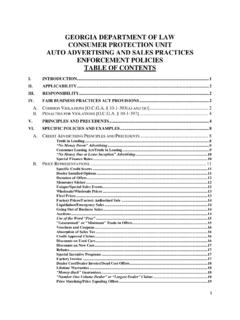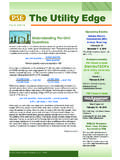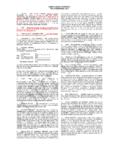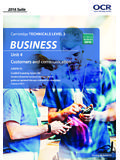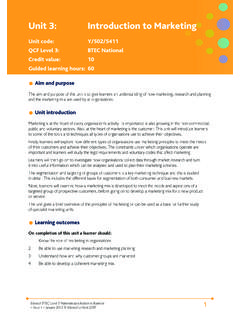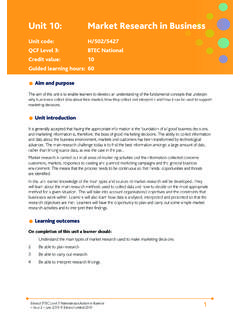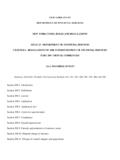Transcription of Cambridge TECHNICALS LEVEL 3 BUSINESS - OCR
1 2016 Suite Cambridge TECHNICALS LEVEL 3. BUSINESS . unit 5. Marketing and market research F/507/8152. Guided learning hours: 60. Version 3 Assessment guidance and Opportunities for applying learning across units updated - August 2016. First teaching September 2016. LEVEL 3. unit 5: Marketing and market research F/507/8152. Guided learning hours: 60. Essential resources required for this unit : Market research proposal to initiate the learners' research This unit is internally assessed and externally moderated by OCR. unit AIM. Marketing is the function that makes sure a BUSINESS sells the right products, at the right price, in the right place, using the most suitable promotion methods. Successful marketing is essential if a BUSINESS is to survive in a very competitive BUSINESS world. The unit has particular emphasis on the role of market research and how it contributes to marketing decision-making, and the actions a BUSINESS may take.
2 Market research is the process by which organisations obtain the information they require. You will gain an in-depth understanding of primary and secondary market research methods used to inform marketing decision-making and any constraints on marketing activities. You will develop an understanding of the importance of selecting appropriate market research methods for market research proposals and you will be able to carry out market research, analyse the market research findings and present the findings. You can build on your skills by studying the other Marketing units in this qualification. OCR 2015 1 unit 5: Marketing and market research First teaching September 2016. TEACHING CONTENT. The teaching content in every unit states what has to be taught to ensure that learners are able to access the highest grades. Anything which follows an details what must be taught as part of that area of content.
3 Anything which follows an is illustrative. It should be noted that where is used, learners must know and be able to apply relevant examples in their work, although these do not need to be the same ones specified in the unit content. For internally-assessed units you need to ensure that any assignments you create, or any modifications you make to an assignment, do not expect the learner to do more than they have been taught, but must enable them to access the full range of grades as described in the grading criteria. Learning outcomes Teaching content The Learner will: Learners must be taught: 1. Understand the (When introducing this learning outcome, teachers should cover the role of marketing in meaning of key terms such as: businesses market marketing ( customer needs and wants, demand, customer satisfaction). marketing objectives marketing analysis marketing strategy marketing mix marketing campaign).
4 An introduction to the marketing function, purpose of the marketing function o how the marketing function links with other functions of a BUSINESS ( Operations/Production, Finance, Human Resources). setting marketing aims and objectives linked to strategic objectives the stages involved in marketing, o BUSINESS objectives o market analysis o marketing strategy o marketing mix How businesses use market analysis, to identify market structure ( number of firms, market share, market size, market volume, market value). to identify potential market growth opportunities/downsizing to recognise competitors ( competitor analysis, market mapping). OCR 2015 2 unit 5: Marketing and market research First teaching September 2016. Learning outcomes Teaching content The Learner will: Learners must be taught: to carry out market segmentation, o methods, demographic geographic behavioural psychographic o benefits of market segmentation for a BUSINESS ( competitiveness, retention).
5 How the impact of marketing can be measured, sales ( trends). income ( sales revenue). awareness ( customer feedback). 2. Know the The main elements and impacts of constraints on marketing, constraints on legal constraints ( Consumer protection legislation). marketing voluntary constraints ( Advertising Standards Authority (ASA), Advertising Codes of Practice). ethical constraints ( invasion of privacy, stereotypes, regulations (ASA)). cultural constraints ( language, international differences). financial constraints ( budget, cash flow, liquidity). technical constraints ( IT limitations, legislation, budget). employees ( quantity, quality and skills of employees). broadcast codes (Ofcom). limitations, penalties trading standards 3. Be able to carry out (When introducing this learning outcome, teachers should cover the market research for meaning of key terms such as: BUSINESS market research opportunities market research proposal).
6 The purpose of market research ( importance, gain better understanding of market ). Methods and types of researching, method o primary o secondary type o qualitative research ( subjective views, attitudes and opinions). o quantitative research ( facts, figures, analysis). OCR 2015 3 unit 5: Marketing and market research First teaching September 2016. Learning outcomes Teaching content The Learner will: Learners must be taught: Tools used to carry out primary market research and how to use them, observation focus groups surveys/questionnaires technology-based ( social media analysis, mobile surveys, online communities). sampling, o probability, random stratified cluster systematic o non probability, quota convenience judgement qualitative and quantitative question, o how to write and sequence questions o methods of response ( Likert, optional routes, outcomes).
7 Sources for secondary market research, internal sources ( loyalty cards, sales figures, stock control). external sources, o commercial sources ( market research organisations). o competitors company reports and websites o government publications o trade publications o the media How to carry out market research using primary and secondary methods Factors that influence the choice of market research methods, types and tools to be used, reasons for market research ( informed by the market research proposal, aims and objectives for market research). availability of resources ( budget, time, number and range of participants to be questioned, location, incentives to take part, permissions to use data). reporting requirements ( timing, format of presentation of results: reports, graphs, charts). Benefits and drawbacks ( cost, time, resources, accuracy, relevance) of methods, types and tools of market research OCR 2015 4 unit 5: Marketing and market research First teaching September 2016.
8 Learning outcomes Teaching content The Learner will: Learners must be taught: 4. Be able to validate How to prepare market research findings ( examining raw and present market data, addressing incomplete responses). research findings How to validate market research findings, how to interpret findings from market research how to assess the reliability of the findings ( repeatability of research findings, size of sample, how it was collected, how many respondents were surveyed, time taken/allocated for the research). how to assess the validity of the findings ( do the findings measure what the market research campaign/exercise intended to measure?). how to identify any limitations of the findings and recommend what areas may require additional market research how to draw conclusions from the findings to inform marketing decisions How to present findings clearly in a format appropriate to the data obtained and audience, quantitative analysis, o simple statistical analysis ( mean, median, mode, range).
9 O data presentation ( pie charts, bar charts, line graphs, histograms). presentation methods;. o written reports ( how to structure a report using appropriate headings such as: introduction, research objectives, main findings, conclusions proposing actions of what marketing decision the BUSINESS can take next, recommendations for any further market research). o presentations ( how to structure a presentation or report using appropriate slides such as: introduction, research objectives, main findings, conclusions proposing actions of what marketing decision the BUSINESS can take next, recommendations for any further market research). OCR 2015 5 unit 5: Marketing and market research First teaching September 2016. GRADING CRITERIA. LO Pass Merit Distinction The learner will: The assessment criteria are the Pass To achieve a Merit the evidence must To achieve a Distinction the evidence requirements for this unit .
10 Show that, in addition to the Pass must show that, in addition to the pass criteria, the candidate is able to: and merit criteria, the candidate is able to: 1. Understand the role of P1*: Explain the role of the marketing marketing in businesses function in BUSINESS P2*: Describe how carrying out market analysis can benefit a BUSINESS P3*: Explain how businesses measure M1: Analyse the impact of a particular the impact of their marketing, using at marketing campaign run by a specific least two contrasting businesses BUSINESS P4*: Describe the constraints on 2. Know the constraints on marketing for a specific BUSINESS marketing P5*: Select market research method, M2: Based on own research, assess D1: Justify the choice and sequence of 3. Be able to carry out type and tools for a market research the choice of market research method questions used in the market research market research for proposal and give reasons for the and type used, explaining their BUSINESS opportunities choice effectiveness P6*: Conduct primary and secondary research to identify BUSINESS opportunities for a specific BUSINESS P7*: Assess the validity of market M3: Based on assessment of own D2: Recommend and justify marketing 4.










